|
Star Wars
Knights of the Old Republic 2: The Sith Lords (XBox)
From
Obsidian
The original
KOTOR, which came out in the middle of 2003, was the game that
made me change my thoughts on the XBox. This was the game that
made me realize that the XBox could do more than FPS and
sports games. KOTOR also went on to win numerous accolades
from the gaming community. This included a few times being
called the best game of 2003.
So, when
KOTOR 2 came out, the fanfare was, surprisingly, far more
subdued. People either ignored it, or based all of their
initial thoughts on the fact that it had the same (great
looking) visuals and (easy to handle but fun to play) engine
as the original. Few people seemed to pick up K2 in comparison
to those who took the chance with K1. So, does it really
deserve this lack of acknowledgement? Is it just a sequel in
name and actually an expansion pack at best?
Plot
This is what
really matters in all non-MMO-RPGs. You don't play an RPG to
simply look at eye candy and enjoy a fast paced action game.
You plan an RPG to be immersed in a story, complete with it's
world, characters, background, history, and in a sequel, you
get to see how things have changed from the first game.
I'm trying
for no spoilers for K1, so bear with some vagueness. KOTOR
ended with a great battle of Sith versus Jedi and Republic.
Whether you played light or dark side in K1, the game still
ended with an abrupt end to what happened to the Sith army, if
the Republic could recover from the war, and the future of the
Jedi. Well, K2 picks up a few years later. In this timeline,
Darth Revan's decisions after the final level of K1 are left
in the air. He may have gone on a personal crusade for or
against domination of the galaxy. However, for sure we know
that the world of Telos (the first world on K1) was destroyed,
Dantooine (the world of the Jedi academy in K1) is in ruins
after a major Sith offensive during the war, the Jedi are gone
from the universe, and the Sith are just legends and rumors
after Korriban (also from K1...the Sith academy) was left
barren and in ruins (in more ruins, I should say).
You begin as
some former Jedi who was exiled from the Jedi order after
following Revan and Malak in the Mandelorian Wars (the wars
that took place shortly before the original KOTOR). You had
given yourself up after finding the council had sealed your
access to the Force. After that time, you had decided to
travel the universe, alone and bitter, to find yourself. You
begin on the Ebon Hawk (the ship from K1) severely injured
after a Sith assault on the ship you originally were a
passenger of. Shortly after this, with the help of some driods
(including the T3 unit from K1), the Ebon Hawk arrives at the
Perragus Mining Station. You remain in a coma in a Kolto tank
(healing tank).
When you
finally wake up, you learn that everyone on the mining station
was killed by severe mechanical malfunctions (mining droids
trying to mine organics and random explosions...and
ventilation systems pumping out poison gas). You are nearly
alone. Nearly because you soon find a spooky looking woman
named Kreia, who seems to know a little too much of your past
as a Jedi and looks a lot like one herself. To make things
more interesting for our loner hero, he has some sort of bond
with this woman so that she can speak telepathically with him
(I'm assuming you play a male character since I chose a male
character). You also come across the only other remaining
organic, a prisoner named Atton who serves as K2's Han Solo.
He's abrupt, blunt, rude, but still serves as a force of good
to counter-balance Kreia and her unusual style of neutral
"justice" (which includes such lessons as "your
followers are to be used and then disposed of when they no
longer have anything to offer you").
Eventually,
you will meet up with your friendly T3 droid (imagine an older
version of R2D2), and escape from Perragus. You will then see
such worlds as Dantooine, Korriban, and Telos from KOTOR. Plus
you will also see Nar Shaada (a moon orbiting the home world
of the Hutts), Dxun (the moon of Onderon that the Mandelorians
started their galactic war from), and Onderon itself. In essence,
the worlds from K1 may seem like redundancy, but they offer
some interesting new areas and twists considering how they all
met their own unique fates either during or after KOTOR. For
example, Dantooine is now in ruins, the people are struggling
to survive, anger toward Force users (that included you) runs
high, and the Jedi Enclave is now in ruins. You will revisit
some locations from the original, but usually they will
contain plenty of new twists and a few extra areas are now
included.
Also, as you
play, you will encounter, not counting yourself, ten other
people who will follow your whims. Actually, I should say you
will have the chance of encountering ten people out of twelve
total (one character choice is determined by your alignment,
and another choice is made depending on if you're playing a
male or female character). Each one will come with their own
back stories, motivations, hopes, and potentials to alter the
plot.
Ultimately,
the plot is far more structured in it's open-ended methods
than it was in KOTOR. For example, in KOTOR, the decision of
being light or dark made no bearing on the actual plot until
about 3 hours before the game ended. However, in K2, while the
major plot decisions wont be as sorely affected by your
alignment, character reactions and quest options will be
strongly influenced by gender and alignment. You can even
expect your party to note when you seem to be particularly
light or dark sided. Also, many quests in the game give you
the option of playing for a good side or an evil side, and
this won't ultimately change the direction of the plot in the
long run, but it will change the plot in the short-term.
So, in the
end, you have a far more immersive plot this time around. The
plot will contain numerous twists and turns, characters in and
out of your group will effect how you see the world and how
the plot is shown, the loose ends of K1 are (for the most
part) tied up, and you are given one of the most immersive
plots seen on a console RPG. You just have to get through a
lot of spoken dialogue (every line is spoken, and most are
said by people you can understand), which is easy to do if you
are ready for a good RPG and not just some damned RPG poser.
You will be hard pressed to find something more involving than
the plot of K2 (besides Xenogears).
Game
Play
I'll keep a
good deal of this to the point. If you played KOTOR,
then you know the majority of the game (and if not, why
not? Actually click on the link to see a breakdown of
that marvel among RPGs). The engine is the same engine that
Bioware gave us in K1. You have the same combat/adventure
menus, the same easy to use controls, the same three people in
a party mechanics. The menus screens are also the same, for
the most part, as we had in KOTOR. In fact, since this is
definitely a game for people who played the original, and
since the original was so widely played, I will just go over
the changes.
The first
change I noticed, as I played, was the weapon equip options.
Instead of having to change your equipment from the main
equipment menu every time you would like to go from a melee to
a ranged weapon, you now have two weapon slots (per
hand...unless your character only has one hand...one person
does have this problem). You can put whatever set up for these
two weapon configurations that you want (usually you'll chose
melee and ranged, but you could always have a droid killing
weapon in one set up and a organic slayer in the other, etc),
and then using a option on your main adventure/combat menu,
you can change weapons on the fly. This will save you a good
deal of either time or frustration. Especially this will help
when you're playing in a party of one and need to go, in a
hurry, from ranged to melee over and over.
However, the
second change I found, which was about the most impressive
change, for me at least, was the "influence" system.
In the game, as you talk and act out in front of your party,
they may take note of your actions and words. Then, you will
usually be prompted with either praise if you did something
that fits an NPCs behavior, or you will be presented with a
question or a demand to justify your actions if you did
something less than favorable. If you did the latter, then you
will be able to either justify your actions or to tell the
player to shut the hell up. This will either build or diminish
how influential you are to your party. Both sides of the coin
have advantages, but to be influential is usually the best
option.
As you gain
influence, some new conversation topics become unlocked and
you are given a chance to better learn said person's back
story. Also, with almost all the humanoid characters, you can
then unlock the ability to train then to become Jedi. This
means you can turn your nearly useless scoundrel (Atton was
useless for me once I had learned all of the skills he knew,
but better) into a force using madman. Or, better yet, when
you have a soldier, like Handmaiden, you could turn her into a
Jedi Guardian to bring about not only lightsaber action, but
also she can be a new party buffer.
However, you
can also have fun with losing influence. If you decide that
someone has been too nice to you, you can turn the tables and
make then leave you alone. This only really works for evil
minded players, but it can be fun. Also, as influence is built
or lost, the NPCs will start to shift their alignment to match
yours. That means if you go full light or dark and gain your
side mastery (another new feature; if you go fully light or
dark, you will get a stat boost based on your class...like
guardians get strength boosts) and have high influence all
across the party, more people will have
mastery along side you.
Beyond these
features, the only really new feature is based on alignment.
Starting with the prestige classes; these work much like
changing into a Jedi did in KOTOR1. You will be able to change
from a physical class like the guardian to a skill based one
like the Jedi Watchman. Or you could remain what type you were
and become more refined. Whatever you chose. There are a total
of three starting classes (same Jedi classes as in the d20
game and KOTOR1) and then there are three dark side and three
light side prestige classes, which are only available to the
main character and only if he/she is about 3/4 light or dark
in alignment. Each prestige unlocks access to a certain new
set of abilities. For example, the Sith Lord (evil mage type)
gets access to the power Force Crush; the most powerful
offensive ability in the game. Also, the Sith Assassin and the
Jedi Watchman (the sentinel based prestige classes) get Force Camouflage
which allows you to use stealth without a stealth generating
belt...basically opening up an additional equipment slot while
retaining stealth...plus they both get sneak attack to take
advantage of their great stealth skills.
The other
new change is game play that deals with alignment is the way
in which people react to you. In KOTOR, people only noticed
your alignment if it was a key plot point which involved
alignment (like the option of killing your good party people
or keeping them all with you at the end of the game). In
KOTOR2, you will be commented to, time and again, about how
you look haggard or are too cruel, even when not actually
acting that way at the time, just because you're a touch too
much to the dark side. Also, your generosity and kindness will
be brought up time and again if you feel inclined to travel
the light side.
Beyond these
changes, the game is still the same old engine and game play
found from KOTOR. You can still stack a few actions in a row
to perform in combat, you still have a party of three at a
time, you still have side quests, you still have to earn that
old lightsaber, you still have a scoundrel pilot for the same
old Ebon Hawk, you still pause with the white button, you
still pull out your lightsaber and do a cool twirl with the Y
button, you still have the same powers and feats (with a few
nice additions, but mostly just old ones), etc. There is
nothing too much that's new, but there is no problem with
that. KOTOR looked hella good in 2003 and KOTOR2, using the
same engine, still looked really sweet in 2004, and now in
2005 it's still nearly flawless...except you can expect more
bugs this time around. The game will freeze even more in
KOTOR2 than in KOTOR. If it wasn't for the bugs, this would be
the ideal for all RPG engines, and with the bugs it's still
heads above most of the competition.
Visuals
The exact
same as KOTOR. This is not a bad thing since KOTOR still looks
pretty. Anyone who tells you that the visuals should look
better with a game that's a year and a half newer than the predecessor
is full of shit. The game looks great. Nothing new doesn't
always mean a game is bad; it could simply mean the game was
great the first time around and is still great in the
present.
Audio
Same deal.
It is all the same as KOTOR, but with far less annoying
repeated alien dialogue. The few alien spoken lines are far
more varied and not just the same damned line of Twil'ik over
and over again, like it was in KOTOR. Once again, every line
is spoken and displayed as text. Also, once again, the voice
acting is some of the best you'd find in a game. When someone
is pissed they sound pissed (press someone about something too
personal and they will snap at you), when they are amused they
sound amused, and when someone is scared (this is for you dark
side players) they sound terrified.
All of the
same sound effects from KOTOR and from the SW films are back.
Lightsabers, engine sounds, Wookie speak (I know, it's
something like Shreewook, but I don't want to admit to being
that big of a geek in the SW world), Huttese (Hutt speak),
blasters, automatic doors...it is all just like you remember.
And in all honesty, if the sounds were updated and changed, we
would not enjoy it; what's SW without the trademarked SW
sounds?
Conclusion
Despite the
claims that KOTOR 2 has the underlying flaw of being more of
the same, it can be seen that keeping a sequel true to it's predecessor
has it's merits. KOTOR 2 uses the same old awe inspiring
mechanics and engine to keep the game play solid, it uses the
same breath taking visuals, and it keeps the same favorite
sounds from the SW films and games. At the same time, the plot
recaps the original's plot to keep new fans interested and
intrigued (even possibly helping to push the original KOTOR to
a new audience), but it draws out and concludes the story of
the original to keep the long time KOTOR fans interested.
While the game may be heavy on dialogue, this is only a
failing if you are more obsessed with "the grind"
than with the plot...and if so, I have 6 letters for you;
MMORPG. This is a typical RPG and therefore the plot is king.
So, assuming you are part of the intended audience for this
game, or even new to RPGs but interested in plot, KOTOR
2 definitely deserves a 9.5 out of 10
(if not for the constant freezing and saving bugs, this would
beat KOTOR's 9.8 in an instant). It only brings about further
progress with an engine and setting that was, and now still
is, far ahead of it's time.
Malik
|
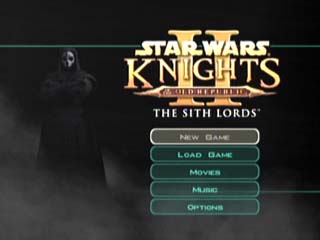

You
will need to get used to the following screen all over again
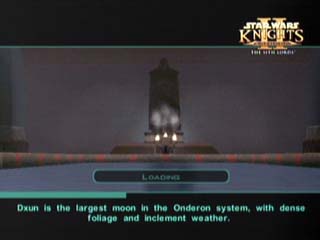
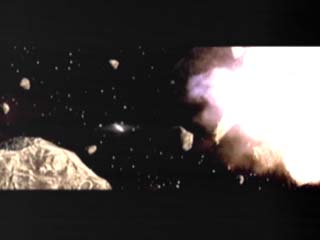
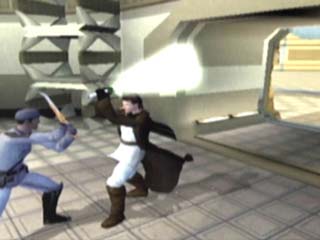
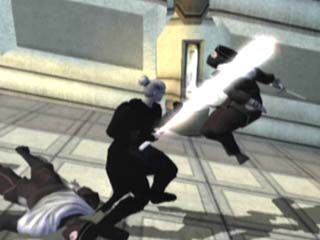
Imagine
this man as a Sith...you're wrong...He looks like Santa Claus
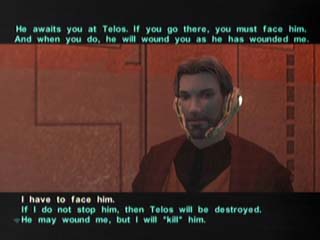
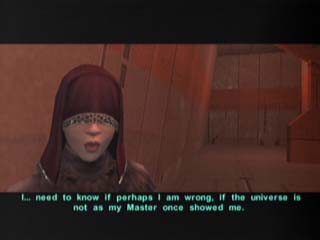
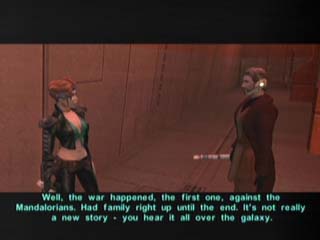
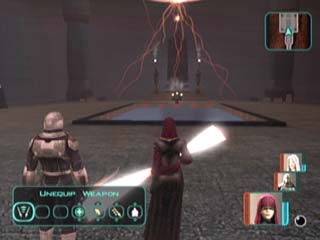
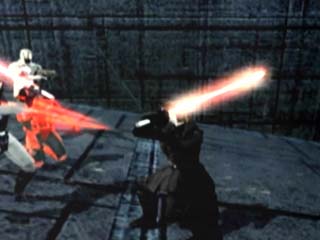
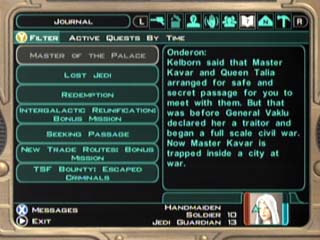
Notice
the additional weapons slots...yeah, that's nice
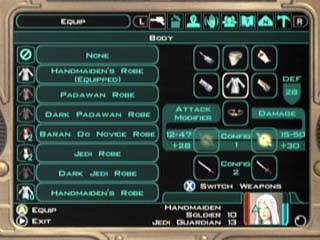
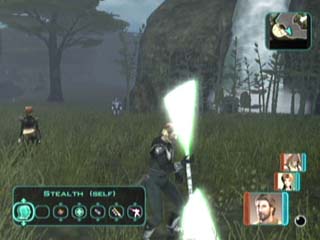
Get
ready for a lot of force powers...
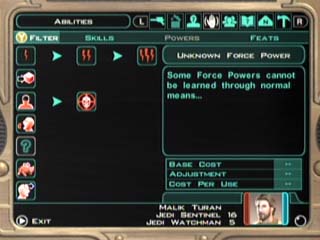
...Like
Force Sight
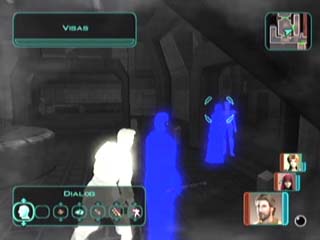
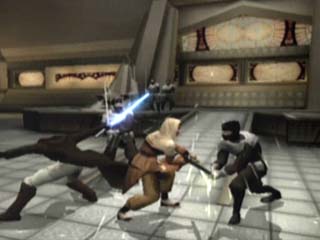
|

